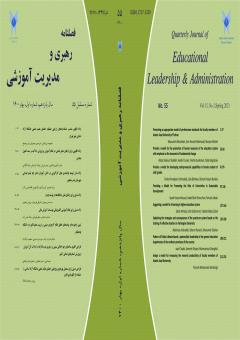Analyzing the management model for reducing students' attraction to illegal virtual spaces on social networks
Subject Areas :Zahra Rahmat Alizadeh 1 , Nasim Majidi Ghahroodi 2 * , Vahid Rashidvash 3
1 - PhD. Student, Department of Social Communication Sciences, Central Tehran Branch, Islamic Azad University, Tehran, Iran.
2 - Assistant Professor, Department of Social Communication Sciences, Central Tehran Branch, Islamic Azad University, Tehran, Iran.
3 - Assistant Professor, Department of Social Sciences, Central Tehran Branch, Islamic Azad University, Tehran, Iran.
Keywords: Cyberspace management, principles of illegal religion, users, students.,
Abstract :
Purpose: The present study aimed to investigate a management model for reducing students' attraction to illegal rituals at the level of social networks.
Method: Method: The research method is qualitative and based on the content analysis technique. The statistical population of the present study to answer the research questions is the published materials and content regarding illegal rituals on the social networks Telegram and Instagram, including films, images (photos, drawings, paintings, . . . ), written text, and audio. Due to the limitations of the statistical population, to answer the research questions, all published content regarding Satanism on the most visited pages and channels on Instagram and Telegram, including videos, images (photos, drawings, paintings, etc.), written text, and selected audio, were examined and analyzed.
Results: Based on the research results, a set of common themes and techniques have been identified. These contents frequently emphasize the principles of individualism and autonomy and make harsh criticisms of organized religion and traditional morality. Symbols such as the pentagram and Baphomet are used as identity symbols on these pages, and the philosophy of hedonism is one of the most central themes.
Conclusion: Therefore, it is suggested that during school, the culture of using new facilities be taught and textbooks titled Information Technology be developed and taught in schools, where the opportunities and threats of this new knowledge are addressed, and children are introduced to its advantages and disadvantages.
ایمانی، آوا.، رفیعی، عادل. (۱۳۹۸). چندمعنایی ترکیبات "چشم" در زبان فارسی: رویکرد صرف ساختی. زبانشناسی و گویش های خراسان. ۱۱(۲). . 11(2): 115-140.
بهروزی بخش، امیرحسین و سمیع پورگیری، محمد و عامری، احمد. (۱۳۹۶). مدلسازی فرآیند حذف رطوبت از گاز طبیعی به روش جذب سطحی با استفاده از جاذب¬های زیولیتی، چهارمین کنفرانس بین المللی نوآوری¬های اخیر در شیمی و مهندسی شیمی، تهران. ۲۳۹-۲۳۱.
خاکی، غلامرضا. (1379). روش تحقیق با رویکردی به پایان نامه نویسی، تهران، وزارت فرهنگ و آموزش عالی، مرکز تحقیقات علمی کشور؛ کانون انتشاراتی درایت، چاپ اول.
خانیکی، هادی و یزدیان، امیر. (1400). واکاوی حوزه مطالعاتی دین و رسانه¬های نوین؛ مروری بر پیشینه، مفاهیم و نظریه¬های رایج با تأکید بر رویکرد ساخت اجتماعی دینی فن آوری، فصلنامه مطالعات رسانه¬های نوین، ۷(۲۵): ۳۶-۱.
رضائی، محمد. (1400). نقش رسانه¬ها در میزان آشنایی دانشجویان با فرقه¬های شیطان پرستی (مطالعه موردی: دانشجویان دانشگاه آزاد اسلامی واحد اردبیل)، فصلنامه مطالعات معرفتی در دانشگاه اسلامی، ۲۵ (۸۸): ۹۰۴-۸۸۳.
شعبانی، محمدجواد و صادق نیا، مهراب و میرتبار، سیدمرتضی. (1398). بررسی مؤلفه امید در سبک زندگی دینی و نقش رسانه دیداری تلویزیون در گسترش امیدآفرینی دینی، پژوهش نامه سبک زندگی، ۵(۱): ۱۴۴-۱۱۵.
کافی راد، مصطفی، عبدالرحیمی، علی رضا و بهزاد، فرج. (1399). تحلیلی بر شیطان پرستی و راه¬کارهای تربیتی مقابله با آن، با الهام از آیات قرآنی، دوفصلنامه آموزه¬های تربیتی در قرآن و حدیث، دوره: ۶(۱): پیاپی ۱۱: ۱۰۳-۸۵.
Al-Zaman, M. S. (2022). Social mediatization of religion: islamic videos on YouTube. Heliyon, 8(3), e09083.
Castaño-Pulgarín, S. A. , Suárez-Betancur, N. , Vega, L. M. T. , & López, H. M. H. (2021). Internet, social media and online hate speech. Systematic review. Aggression and Violent Behavior, 58, 101608.
Clarke, V. & Braun, V. (2013). Teaching thematic analysis: Overcoming challenges and developing strategies for effective learning. The Psychologist, 26(2), 120-123.
Gomez, C. T. (2021). Social solidarity as a dimension of transitional justice: the case of Cartography and Identification of Mass Graves in post-conflict Colombia. The International Journal of Human Rights, 1-24.
Hashmi, U. M. , Rashid, R. A. , & Ahmad, M. K. (2021). The representation of Islam within social media: a systematic review. Information, Communication & Society, 24(13), 1962-1981.
Larsson, A. O., Tønnesen, H., Magin, M., & Skogerbø, E. (2024). Calls to (what kind of?) action: A framework for comparing political actors’ campaign strategies across social media platforms. New Media & Society, 14614448241229156.
Short, M. B. , Kasper, T. E. , & Wetterneck, C. T. (2019). The relationship between religiosity and internet pornography use. Journal of Religion and Health, 54(2), 571-583.
Tomlinson, J. (۲۰۱۳). Globalization and Culture, Cambridge: Polity Press.
Wallis, R., & Buckingham, D. (2019). Media literacy: The UK’s undead cultural policy. International Journal of Cultural Policy, 25(2), 188-203.

